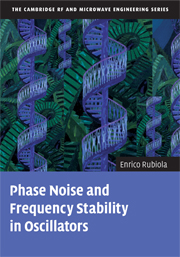
E. Rubiola
Phase noise and frequency stability in oscillators
Cambridge University Press, 2008
 |
E. Rubiola Phase noise and frequency stability in oscillators Cambridge University Press, 2008 |
|
Presenting a comprehensive account of oscillator phase-noise and frequency stability, this practical text is both mathematically rigorous and accessible. An in-depth treatment of the noise mechanism is given, describing the oscillator as a physical system, and showing that simple general laws govern the stability of a large variety of oscillators differing in technology and frequency range, and in lasers. Special attention is given to amplifiers, resonators, delay lines, feedback, and flicker (1/f) noise. The reverse engineering of oscillators based on phase-noise spectra is also covered, and end-of-chapter exercises are given. Uniquely, numerous practical examples are presented, including case studies taken from laboratory prototypes and commercial oscillators. Based on tutorials given by the author at the Jet Propulsion Laboratory, international IEEE meetings, and in industry, this is a useful reference for academic researchers, industry practitioners, and graduate students in RF and communications engineering.
Contents: Important notice: this book supersedes and makes obsolete the draft version E. Rubiola, The Leeson effect - Phase noise in quasilinear oscillators, arXivphysics/0502143, February 2005. |
Supplementary Material |
Open literature
Seminars
Seminars on related subjects
|
| back to top |
Download the spectra of Chapter 6
|
||||||||||||||||||||||||||||||||||||||||||||||||||||
| back to top |
AcknowledgementsThe gratitude I owe to my colleagues and friends who contributed to the rise of the ideas contained in this book is disproportionate to the small size: R. Brendel, G. Brida, G. J. Dick, M. Elia, P. Féron, S. Galliou, V. Giordano, C. A. Greenhall, J. Groslambert, J. L. Hall, V. S. Ilchenko, L. Larger, L. Maleki, A. B. Matsko, M. Oxborrow, S. Römisch, A. B. Savchenkov, F. Vernotte, N. Yu. Special thanks to L. Maleki for the opportunity of spending four long periods at the JPL and for numerous discussions and suggestions. To G. J. Dick, for giving invaluable ideas and suggestions during numerous and stimulating discussions. To R. Brendel, M. Oxborrow, and S. Römisch for personal effort in reviewing the manuscript, and for a wealth of suggestions and criticism. To V. Giordano for supporting me for more than 10 years, and for his contribution with frequent and stimulating discussions. Thanks to Roberto Bergonzo for the superb picture on the front cover, entitled "The amethyst stairway." |
| back to top |